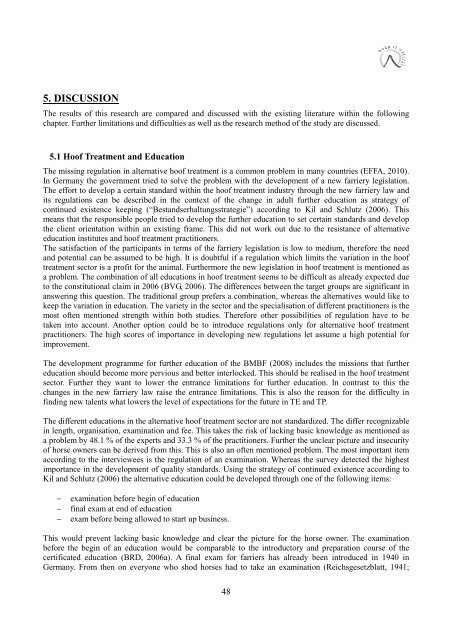Bachelor Thesis - Christina Kuenen - Hufpfleger
Bachelor Thesis - Christina Kuenen - Hufpfleger
Bachelor Thesis - Christina Kuenen - Hufpfleger
Create successful ePaper yourself
Turn your PDF publications into a flip-book with our unique Google optimized e-Paper software.
5. DISCUSSION<br />
The results of this research are compared and discussed with the existing literature within the following<br />
chapter. Further limitations and difficulties as well as the research method of the study are discussed.<br />
5.1 Hoof Treatment and Education<br />
The missing regulation in alternative hoof treatment is a common problem in many countries (EFFA, 2010).<br />
In Germany the government tried to solve the problem with the development of a new farriery legislation.<br />
The effort to develop a certain standard within the hoof treatment industry through the new farriery law and<br />
its regulations can be described in the context of the change in adult further education as strategy of<br />
continued existence keeping (“Bestandserhaltungsstrategie”) according to Kil and Schlutz (2006). This<br />
means that the responsible people tried to develop the further education to set certain standards and develop<br />
the client orientation within an existing frame. This did not work out due to the resistance of alternative<br />
education institutes and hoof treatment practitioners.<br />
The satisfaction of the participants in terms of the farriery legislation is low to medium, therefore the need<br />
and potential can be assumed to be high. It is doubtful if a regulation which limits the variation in the hoof<br />
treatment sector is a profit for the animal. Furthermore the new legislation in hoof treatment is mentioned as<br />
a problem. The combination of all educations in hoof treatment seems to be difficult as already expected due<br />
to the constitutional claim in 2006 (BVG, 2006). The differences between the target groups are significant in<br />
answering this question. The traditional group prefers a combination, whereas the alternatives would like to<br />
keep the variation in education. The variety in the sector and the specialisation of different practitioners is the<br />
most often mentioned strength within both studies. Therefore other possibilities of regulation have to be<br />
taken into account. Another option could be to introduce regulations only for alternative hoof treatment<br />
practitioners. The high scores of importance in developing new regulations let assume a high potential for<br />
improvement.<br />
The development programme for further education of the BMBF (2008) includes the missions that further<br />
education should become more pervious and better interlocked. This should be realised in the hoof treatment<br />
sector. Further they want to lower the entrance limitations for further education. In contrast to this the<br />
changes in the new farriery law raise the entrance limitations. This is also the reason for the difficulty in<br />
finding new talents what lowers the level of expectations for the future in TE and TP.<br />
The different educations in the alternative hoof treatment sector are not standardized. The differ recognizable<br />
in length, organisation, examination and fee. This takes the risk of lacking basic knowledge as mentioned as<br />
a problem by 48.1 % of the experts and 33.3 % of the practitioners. Further the unclear picture and insecurity<br />
of horse owners can be derived from this. This is also an often mentioned problem. The most important item<br />
according to the interviewees is the regulation of an examination. Whereas the survey detected the highest<br />
importance in the development of quality standards. Using the strategy of continued existence according to<br />
Kil and Schlutz (2006) the alternative education could be developed through one of the following items:<br />
−<br />
−<br />
−<br />
examination before begin of education<br />
final exam at end of education<br />
exam before being allowed to start up business.<br />
This would prevent lacking basic knowledge and clear the picture for the horse owner. The examination<br />
before the begin of an education would be comparable to the introductory and preparation course of the<br />
certificated education (BRD, 2006a). A final exam for farriers has already been introduced in 1940 in<br />
Germany. From then on everyone who shod horses had to take an examination (Reichsgesetzblatt, 1941;<br />
48


